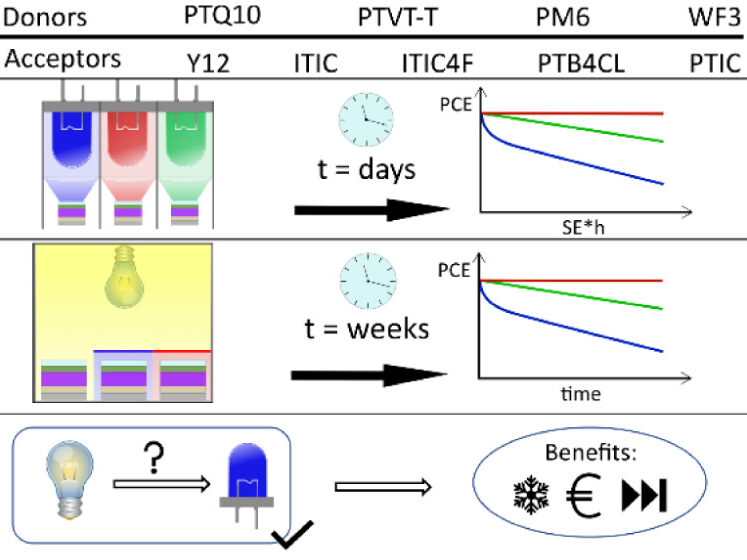Weitz, P., Wortmann, J., Liu, C., Wen, T.-J., Li, C.-Z., Heumüller, T., Brabec, C.J.
ACS Appl. Mater. Interfaces 2024, in press
While wavelength-dependent photodegradation of organic solar cells (OSCs) under visible light is typically discussed in terms of UV/blue light-activated phenomena, we recently demonstrated wavelength-dependent degradation rates up to 660 nm for PM6:Y6. In this study, we systematically investigated this phenomenon for a broad variety of devices based on different donor:acceptor combinations. We found that the spectral composition of the light used for degradation, tuned in a spectral range from 457 to 740 nm and under high irradiances of up to 30 suns, has a crucial influence on the device stability of almost all tested semiconductors. The relevance of this phenomenon was investigated in the context of simulated AM1.5 illumination with metal halide lamps and white LEDs. It is concluded that the current stability testing protocols in OSC research have to be adjusted to account for this effect to reveal the underlying physics of this still poorly understood mechanism.

Weitz, P., Wortmann, J., Liu, C., Wen, T.-J., Li, C.-Z., Heumüller, T., Brabec, C.J.
ACS Appl. Mater. Interfaces 2024, in press
While wavelength-dependent photodegradation of organic solar cells (OSCs) under visible light is typically discussed in terms of UV/blue light-activated phenomena, we recently demonstrated wavelength-dependent degradation rates up to 660 nm for PM6:Y6. In this study, we systematically investigated this phenomenon for a broad variety of devices based on different donor:acceptor combinations. We found that the spectral composition of the light used for degradation, tuned in a spectral range from 457 to 740 nm and under high irradiances of up to 30 suns, has a crucial influence on the device stability of almost all tested semiconductors. The relevance of this phenomenon was investigated in the context of simulated AM1.5 illumination with metal halide lamps and white LEDs. It is concluded that the current stability testing protocols in OSC research have to be adjusted to account for this effect to reveal the underlying physics of this still poorly understood mechanism.